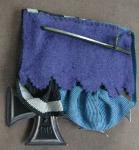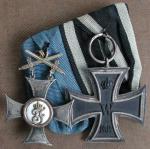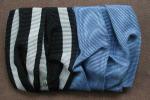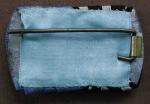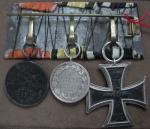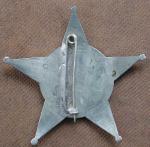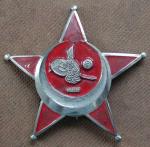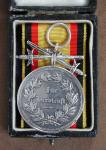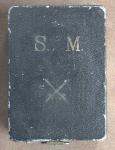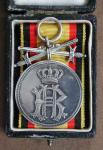-
Posts
949 -
Joined
-
Last visited
Content Type
Profiles
Forums
Blogs
Gallery
Events
Store
Everything posted by David Gregory
-
Don, I considered that explanation but discounted it for the following reasons. If the red and white ribbon were for the Hessisches Kriegsehrenzeichen, which from the award documents I have seen I understand was generally for services rendered on the home front, then it seems unlikely that it would be worn on the same bar as the other Hessen award, unless that were for a non-com grade of the Allgemeines Ehrenzeichen (e.g. for merit or faithful service) or the Milit?r-Sanit?ts-Kreuz worn on the blue ribbon for font-line service. The Waldeck ribbon features a sword device, which also contradicts the non-com status for the Kriegsehrenzeichen. Perhaps my conclusion is a bit simplistic, but the TWM seemed more logical to me. It also matches the following bar, which tempts me to identify it as a TWM: David
-
These two bars might look as they could have belonged to the same man at different times, but they came from quite different sources. When I posted them on the WA forum, Daniel Krause offered the explanation that the longer bar may have belonged to an NCO from a technical branch who served with a W?rttemberg unit and later received his Saxon awards after being promoted to officer status.
-
A simple bar worn by a brave Saxon after 1934 who was awarded the EK2, silver medal of the Military Order of St. Henry, the Friedrich-August and the Frontk?mper-Ehrenkreuz. What would be the rank list abbreviation for the silver and gold medals of the Military Order of St. Henry? [attachmentid=17252]
-
And this Waldeck and Hessen ribbon bar also features the TWM ribbon: [attachmentid=17239] [attachmentid=17240]
-
The quality of the back is consistent with that of the front: [attachmentid=17237] A view from the side shows just how thick it is: [attachmentid=17238]
-
Although I don't yet have any documents to men that received this award, this example has joined my small collection of pinback awards. It seems to be made of plated brass and the paint finish can only be described as "cheap". [attachmentid=17236]
-
DRP is the abbreviation for Deutsches Reichspatent, i.e. German Patent, used until a short time after the establishment of the Federal Republic, when the patent system was changed to DBP = Deutsches Bundespatent (German Federal Patent). DRGM stands for Deutsches Reich Gebrauchsmuster, i.e. utility model or utility patent, later replaced by the DBGM. Although similar in intent, the patent offered (and still offers) longer protection of design rights than the utility model. DRP and DRGM marks can still be found on some products manufactured in the early 1950s.
-
Stogieman is right about the colours of the devices. The poor daylight in which I took the photos this afternoon renders the colours rather badly, which are not easy to discern due to the wear it displays in any case. A close inspection of the bar under bright light shows that the colours are just as he suggests. If these device colours are correct, and not the result of the "salty" condition of the bar, what grades do the ribbons represent? Is the Reuss award the Silver Merit Medal with Swords bestowed to the first owner of the bar as an NCO? Or is it the third or fourth class of the Honour Cross? Would a Feldwebelleutnant have received the fourth class of the Honour Cross or the Gold Merit Medal with Swords? What colour would the devices have been in those cases? An NCO awarded the Silver Merit Medal with Swords might have received the Knights Crosses of the Merit and Albert Orders. Does that make sense and do the devoce colours match this combination? Are any other combinations of awards possible? Thanks in advance, David
-
This bar is typical for those worn by WW1 veterans after 1934. Most of them remain anonymous. However, this one came with the man's Milit?rpass, so it does have a story. [attachmentid=17194] [attachmentid=17195] Albert Oskar K?rner (Oskar to his friends), was born in Tanna near Schleiz in the Principality of Reuss j?ngerer Linie on 19 January 1888. He was single and working as a plumber's assistant when he was called up as a replacement recruit and assigned to the recruit depot of the 1st replacement battalion of Reserve-Infanterie-Regiment 31 on 18 December 1914. In early March 1915, probably after completing his basic training, he was transferred to the 2nd replacement battalion of Infanterie-Regiment 85. Two weeks later, he joined the 7th company of Reserve-Infanterie-Regiment 98. His regiment was part of 9. Reserve-Division and had been in the lines on the Verdun front since the beginning of December 1916. He was closely involved in the vicious fighting that took place when the Germans launched their assault in February 1916. His company was assigned to 10. Reserve-Division for the attack on the eastern edge of Cauri?res Wood on 25 February 1916, which resulted in the capture of Bezonvaux together with 243 prisoners and 8 machine-guns of French Infantry Rgiment 44. Following initial successes, the German attack started to slow down and by early March, the battle had turned into a war of attrition. 9. Reserve-Division was involved in several attacks between 8 and 10 March to take Fort Vaux which, according to confusing reports, was captured by the Germans and then apparently retaken by the French. By the morning of 10 March, his battalion was so exhausted that it was relieved by elements of Reserve-Infanterie-Regiment 37. On 11 March, the division was withdrawn from the fighting. The respite was only short as, on 23 March, Oskar K?rner was badly injured as the result of being buried, probably in a trench that collapsed when bombarded by the French artillery. He was evacuated to a dressing station at Jouvaincourt, where he remained for five days before being transported to a hospital in Germany. His injuries were so severe that he did not leave convalescent care until December 1916, when was assigned to a replacement unit. He was awarded his EK2 on 22 July 1916, almost certainly for the fighting at Verdun. In January 1917 he was fit enough to return to active service and joined the newly raised Infanterie-Regiment 458, which was part of 236. Infanterie-Division and deployed to the new Sigfriedfront. He was involved in the fighting at Arras in May 1917 and all seemed to be going well for him until he was wounded in the left hand by shell splinters on 22 June 1917. After spending a month at Field Hospital 112, he returned to 12. Kompagnie in late July 1917. He spent the rest of 1917 fighting in French Flanders and Artois until the Spring Offensive in 1918, when he was involved in open warfare in Cambrai and on the Scarpe. From April until September 1918 he was either fighting in the Ypres salient or resting in the rear sector held by 4. Amee. In late October 1918 he was promoted to Gefreiter for bravery in the face of the enemy. He spent the last months of the war fighting on the Woevre Plain and in fighting retreats in Champagne and on the Maas. His war ended when he was discharged and returned to Reuss in early December 1918. He received the wound badge in black for two wounds on 18 May 1918 and was awarded his Reuss silver merit medal with swords as shown above on 25 May 1918. My apologies for a slightly off-topic discourse, but some otherwise anonymous medal bars do have a story to tell.
-
This EK, Sachsen-Weimar, Reuss and DA ribbon bar, presumably to an NCO, has been shown elsewhere before, but I include it in this dedicated Reuss thread: [attachmentid=17173] This rather worn Saxon bar also features a Reuss ribbon and various devices. I assume it represents the following awards: EKVerdienstorden mit Schwertern (or perhaps the Verdienstkreuz?)Albrechtsorden Ritter mit Schwertern 2. KlasseReuss Ehrenkreuz (which grade?)Frontk?mpfer-EhrenkreuzIt measures only a few millimetres in height. Is this a style typical for Saxon bars? Would this bar be typical for a well decorated Leutnant or Oberleutnant? What would be the rank list abbreviations for these awards? [attachmentid=17179] [attachmentid=17180]
-

EK 1914 award document without awarding date?
David Gregory replied to Christian L's topic in Germany: All Eras: The Iron Cross
Christian, Unsigned or undated are not common, but they do exist. Most of the documents I have are signed and dated, even the badly faded ones, but I have at least one example each of undated and unsigned iron cross award documents. David





